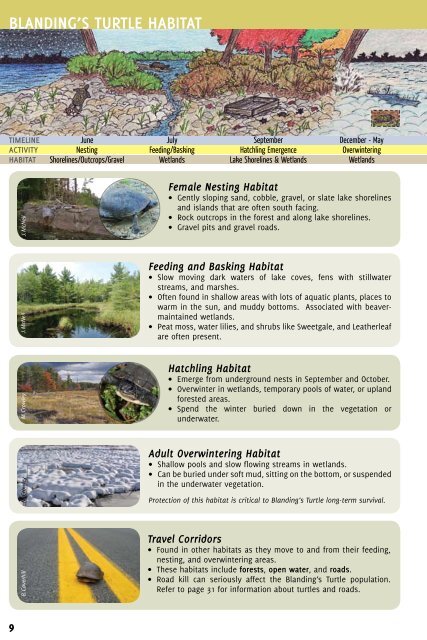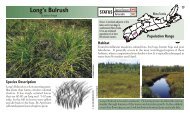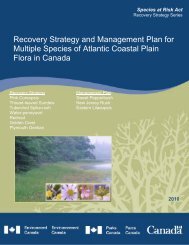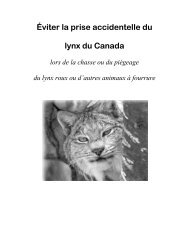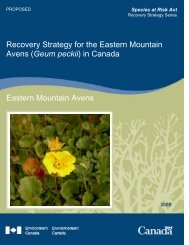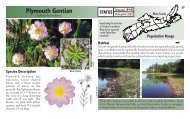Healthy Lakes and Wetlands For Tomorrow - Species at Risk
Healthy Lakes and Wetlands For Tomorrow - Species at Risk
Healthy Lakes and Wetlands For Tomorrow - Species at Risk
Create successful ePaper yourself
Turn your PDF publications into a flip-book with our unique Google optimized e-Paper software.
BLANDING’S TURTLE HABITAT<br />
Timeline<br />
Activity<br />
Habit<strong>at</strong><br />
June<br />
Nesting<br />
Shorelines/Outcrops/Gravel<br />
July<br />
Feeding/Basking<br />
Wetl<strong>and</strong>s<br />
September<br />
H<strong>at</strong>chling Emergence<br />
Lake Shorelines & Wetl<strong>and</strong>s<br />
December - May<br />
Overwintering<br />
Wetl<strong>and</strong>s<br />
J. McNeil<br />
Female Nesting Habit<strong>at</strong><br />
• Gently sloping s<strong>and</strong>, cobble, gravel, or sl<strong>at</strong>e lake shorelines<br />
<strong>and</strong> isl<strong>and</strong>s th<strong>at</strong> are often south facing.<br />
• Rock outcrops in the forest <strong>and</strong> along lake shorelines.<br />
• Gravel pits <strong>and</strong> gravel roads.<br />
J. McNeil<br />
Feeding <strong>and</strong> Basking Habit<strong>at</strong><br />
• Slow moving dark w<strong>at</strong>ers of lake coves, fens with stillw<strong>at</strong>er<br />
streams, <strong>and</strong> marshes.<br />
• Often found in shallow areas with lots of aqu<strong>at</strong>ic plants, places to<br />
warm in the sun, <strong>and</strong> muddy bottoms. Associ<strong>at</strong>ed with beavermaintained<br />
wetl<strong>and</strong>s.<br />
• Pe<strong>at</strong> moss, w<strong>at</strong>er lilies, <strong>and</strong> shrubs like Sweetgale, <strong>and</strong> Le<strong>at</strong>herleaf<br />
are often present.<br />
M. Crowley<br />
H<strong>at</strong>chling Habit<strong>at</strong><br />
• Emerge from underground nests in September <strong>and</strong> October.<br />
• Overwinter in wetl<strong>and</strong>s, temporary pools of w<strong>at</strong>er, or upl<strong>and</strong><br />
forested areas.<br />
• Spend the winter buried down in the veget<strong>at</strong>ion or<br />
underw<strong>at</strong>er.<br />
M. Crowley<br />
Adult Overwintering Habit<strong>at</strong><br />
• Shallow pools <strong>and</strong> slow flowing streams in wetl<strong>and</strong>s.<br />
• Can be buried under soft mud, sitting on the bottom, or suspended<br />
in the underw<strong>at</strong>er veget<strong>at</strong>ion.<br />
Protection of this habit<strong>at</strong> is critical to Bl<strong>and</strong>ing’s Turtle long-term survival.<br />
B. Caverhill<br />
Travel Corridors<br />
• Found in other habit<strong>at</strong>s as they move to <strong>and</strong> from their feeding,<br />
nesting, <strong>and</strong> overwintering areas.<br />
• These habit<strong>at</strong>s include forests, open w<strong>at</strong>er, <strong>and</strong> roads.<br />
• Road kill can seriously affect the Bl<strong>and</strong>ing’s Turtle popul<strong>at</strong>ion.<br />
Refer to page 31 for inform<strong>at</strong>ion about turtles <strong>and</strong> roads.<br />
9


